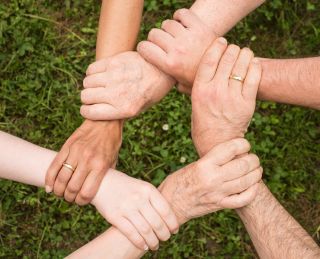Therapy
Eating Disorders Treatment: A New Study Offers Promise
Multifamily therapy shows improvements and low dropout rates.
Posted June 28, 2023 Reviewed by Lybi Ma
Key points
- Multifamily therapy includes various patients’ families meeting together since they all face similar issues.
- Research indicates that multifamily therapy seems to offer a low dropout rate and improvement.
- Sometimes a person seeking help may need to be creative to bridge the gap between research and real life.

Though treatment approaches for eating disorders have been evolving and improving, additional effective treatments are still needed. A recent study reviewing the impact of multifamily therapy on eating disorder symptoms and psychological distress in adolescents offers hope and potential help.
Multifamily therapy means that the patients’ families meet because they face similar issues. They support, learn from, and provide feedback to each other. They receive eating disorders education together.
The study overview
The study published on June 7, 2023, in the Journal of Eating Disorders, referenced 207 adolescent participants, of which 90 percent identified as female. The setting was outpatient, meaning outside of the hospital or 24/7 residential settings. The multifamily therapy served as an adjunct or additional support to outpatient treatment. Finally, more than 90 percent of the participants were diagnosed with anorexia nervosa and atypical anorexia nervosa.
Unpacking study results
The researchers investigated changes such as body weight, self-reported eating disorder symptoms, and psychological problems at various times (for example, before, after, as well as a six-month follow-up). A summary of the results follows (Funderud and colleagues, 2023):
There were significant improvements in the adolescents’ ED [eating disorder] symptomatology, psychological distress and weight from start-of-treatment to six month follow-up. Acceptability of the treatment seemed high, as only 10 percent discontinued treatment. The low dropout is in line with previous MFT [multifamily therapy] studies, as reported in a recent meta-analysis.
Furthermore, the study noted multifamily therapy’s capacity to easily and naturally support various cultures.
The past and the present
Though scant prior research exists, so far, multifamily therapy is a treatment adjunct that has repeatedly shown effectiveness and low dropout rates. One study of family-oriented group therapy reported zero participants dropped out (Salbach and colleagues, 2006). It has other advantages, too. For example, multifamily therapy could be more affordable than many other eating disorder treatments because it's in a group setting. Also, it could provide benefits beyond the reduction in eating disorder symptoms.
It’s mind-blowing that multifamily therapy is generally only offered at or through major treatment centers for their patients and families. Or, like this study, it might be provided to support family-based treatment specifically. It’s rarely found as an outpatient option for those seeking to provide an adjunct to their or their loved one’s outpatient therapy.
What can people do in the absence of available multifamily therapy?
Multifamily therapy is commonly linked to group and single-family therapy (Gelin, 2015). And since it is related to both, people seeking help might pursue either the group setting or family therapy as a more readily available adjunct to someone’s eating disorder treatment.
Friends and family support groups
Support groups are not the same as therapy groups. For example, nonprofessionals may run them, and there is often a disclaimer that support groups do not replace therapy. Yet they still can provide a lot of what multifamily therapy offers. And, regarding accessibility, they are often offered as a community resource (free or low cost) and some are available online.
As an eating disorders specialist, I've run a support group for friends and family members of people with eating disorders for over a decade. People often come in "on eggshells." Then, while someone else is sharing a familiar experience, it tends to normalize or soften the crunch of their eggshells. Feelings of shame and self-blame often subside, and the group members' connection and support increase. Implicit learning tends to happen too, and probably the most important thing people can do to support someone with an eating disorder is to learn about eating disorders.
Support groups (when run by people with extensive eating disorder knowledge and an ability to keep the room safe) can provide eating disorder education and tools. The following statements, which are shared with permission from group participants, sum up well the experience of having a loved one with an eating disorder and the impact a group can make (Spotts-De Lazzer, 2021).:
- "It’s so isolating: the stigma and feeling the need to protect and respect your loved one’s privacy. You start with, 'I can’t let anyone know in my circles.' Or friends and family you tell don’t understand, and that can be isolating, too. Find a safe place to connect and share, like a support group, where you can be completely open.
- "You’ve got to plug into a network of help because you don’t know that you don’t know."
Single-family therapy
Eating disorder-focused single-family therapy is where the family meets and works through issues, addresses the eating disorder, and so on. Most to all family members are present. Especially if a person with an eating disorder lives at home, family therapy can make sense: Seven days a week, multiplied by 24 hours a day, is up to 168 hours a week with family. Many therapists will offer family therapy. However, for the most benefit and effectiveness, please confirm the therapist has legitimate eating disorder training and specialization.
Bottom line
For difficult-to-treat disorders, seekers and providers can sometimes benefit by creatively filling the gap between current research and available practice.
This blog is for informational purposes only and does not constitute therapy or professional advice.
References
Gelin, Z., Cook-Darzens, S., Simon, Y., & Hendrick, S. (2016). Two models of multiple family therapy in the treatment of adolescent anorexia nervosa: a systematic review. Eating and Weight Disorders 21(1), 19-30. doi: 10.1007/s40519-015-0207-y.
Harrop, E. N., Mensinger, J. L., Moore, M. & Lindhorst, T. (2021). Restrictive eating disorders in higher weight persons: A systematic review of atypical anorexia nervosa prevalence and consecutive admission literature. International Journal of Eating Disorders, 54(8), 1328-1357. doi: 10.1002/eat.23519
Spotts-De Lazzer. (2021, March 4). You’re not alone, not the only one experiencing this, and people can help: Loving someone with an eating disorder [blog]. Families Empowered And Supporting Treatment for Eating Disorders.
Funderud, I., Halvorsen, I., Kvakland, A. L., Nilsen, J. V., Skjønhaug, J., Stedal, K., & Rø, Ø. (2023). Multifamily therapy for adolescent eating disorders: a study of the change in eating disorder symptoms from start of treatment to follow-up. Journal of eating disorders, 11(1), 92. doi: 10.1186/s40337-023-00814-y
Salbach, H., Bohnekamp, I., Lehmkuhl, U., Pfeiffer, E., & Korte, A. (2006). Family-oriented group therapy in the treatment of female patients with anorexia and bulimia nervosa--a pilot study]. Z Kinder Jugendpsychiatr Psychothery, 34(4), 267-74. doi: 10.1024/1422-4917.34.4.267.




